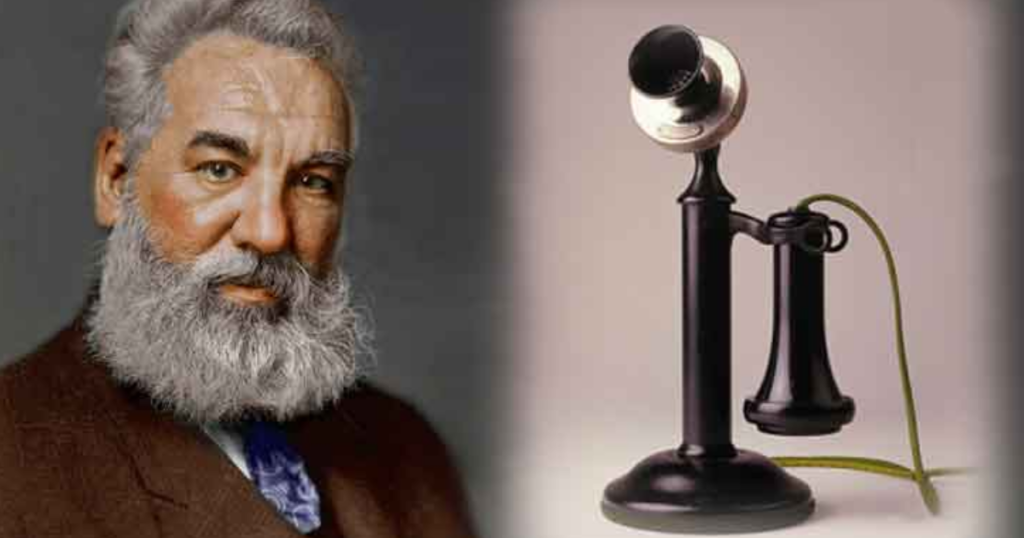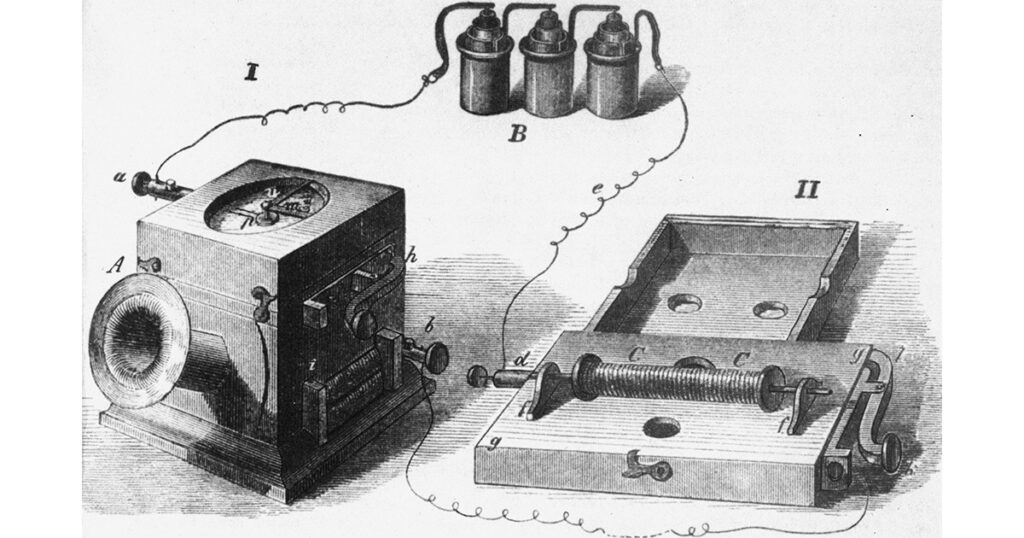The invention of the telephone changed history. It revolutionized how people connect and communicate. The telephone began as an idea. It then evolved. This wonderful telephone’s invention made the age of technology possible. The history of the telephone is filled with innovations. It transformed businesses and everyday life. With the passage of time, the evolution of the telephone has gone from cables to the wireless ones we use today. There are many interesting phone facts in this post. It explores a key invention. It reshaped the business world and still impacts it today.
The Ideation of the Telephone
The idea for the telephone came from a desire to improve telegraphy. Visionaries like Alexander Graham Bell wanted to send the human voice over wires. They sought to create a device to do that. This goal laid the foundation for one of history’s greatest tech advances.

The Birth of Telecommunication
The invention of the telephone marked the official birth of telecommunication. conversation in actual time became possible for the first time. It bridged distances and allowed for faster, more personal interactions. This work set the stage for modern telecom systems, like mobile phones and the Internet.
The History of the Telephone
The history of the telephone is a journey of innovation and persistence. After Alexander Graham Bell’s invention in 1876, the telephone became popular. It gained popularity at a rapid pace. Over decades, innovators added features like rotary dialing, voicemail, and caller ID. These show the phone’s ongoing evolution.

The Evolution of the Telephone
The telephone’s evolution shows a shift. Smartphones have changed from large, attached devices to portable and small ones. Early telephones used manual switchboards. But new technology brought automated systems, wireless connections, and internet integration. Today, phones are multifunctional tools. They do more than voice calls. This shows their adaptability over time.
The Digital Revolution: Telecommunication in Business
The birth of telecommunication as we know it started in the late 20th century with the introduction of digital systems, mobile phones, and eventually, the internet. The shift from landlines to mobile phones and VoIP (Voice over Internet Protocol) transformed business communication by making interactions seamless across continents.
Key Business Milestones Driven by Telephone Advancements
- Call Centers and Customer Service: The telephone enabled businesses to establish dedicated support centers, ensuring better customer engagement and satisfaction.
- Telemarketing and Sales: The rise of telecommunication allowed businesses to expand their reach, creating sales opportunities through direct calls.
- Remote Work and Virtual Collaboration: Modern telecommunication tools such as video conferencing and cloud-based calling systems have revolutionized business operations, allowing global teams to collaborate effortlessly.
- AI and Smart Telephony: With the integration of AI, businesses now use automated answering services, chatbots, and predictive dialing systems to optimize communication and enhance customer experiences.
The Future of Telephones in Business
Looking ahead, telecommunication continues to evolve with technologies like 5G, IoT-enabled devices, and AI-driven customer service solutions. The history of the telephone shows a continuous journey of innovation, ensuring that businesses remain competitive and connected in an increasingly digital world.
A Leap Forward: Instant Communication
The telephone revolutionized business communication. It enabled instant voice calls over long distances. Before its invention, businesses relied on written messages, telegrams, and in-person meetings. These were often slow and limited by geography. The telephone broke these barriers, allowing immediate, real-time dialogue.
Speed and Responsiveness
With the telephone, businesses could address urgent matters with speed. Negotiations, problem-solving, and decision-making no longer required days or weeks of back-and-forth correspondence. A single call could fix issues that needed long emails or travel. It would speed up business operations. This speed allowed companies to stay competitive in fast-evolving markets.
Collaboration Across Distances
The telephone made it easier for teams spread across different locations to collaborate. Managers could issue instant instructions to remote teams. Employees could coordinate projects without delays from being apart. This set the stage for today’s global, distributed workforce.
Strengthening Relationships
Also, to speed up, the telephone added a personal touch to business communication. A voice fosters connection and builds trust. Written words can’t do that. Businesses used this advantage to strengthen ties with clients, suppliers, and partners. It paved the way for long-term collaborations.
Supporting Crisis Management
In moments of crisis, the ability to make immediate calls is invaluable. Businesses were able to react quickly to problems because to the telephone. It helped with supply chain disruptions, customer complaints, and emergencies. This minimized damage and kept operations running.
Examples of Transformation
Early telephone adopters, like banks and law firms, felt its impact. A banker could inform a client of market changes in real time. A law firm could update a client on urgent legal developments. Manufacturers could streamline their supply chains by establishing direct contact with suppliers. These examples show the telephone’s role in reshaping industries. It enabled instant communication.
Challenges and Adaptations
While the telephone brought immense opportunities, it also posed challenges. Businesses had to adapt their communication strategies. Time zones, language barriers, and poor infrastructure forced them to adapt. Despite these hurdles, the benefits of global connectivity far outweighed the difficulties. So, companies invested in telecom networks and multilingual teams.
The Foundation of Modern Globalization
The telephone helped expand global markets. It paved the way for modern tech, like email, video calls, and cloud communication. These tools expand on the telephone’s legacy of instant, reliable, and borderless communication.
International Market Growth
The invention of the telephone played a pivotal role in breaking geographical barriers and fostering global connectivity. It allowed businesses to communicate instantly across borders, streamlining operations and enabling efficient decision-making. This newfound ability to connect with international partners and customers not only enhanced trade relations but also facilitated the expansion of markets. The telephone became a crucial tool for bridging cultural and economic divides, thus laying the foundation for a truly interconnected global economy.
Industry-Specific Transformations
The telephone’s invention revolutionized industries. It enabled faster communication, better coordination, and more efficient operations. The telephone benefited all sectors. But it transformed healthcare, education, hospitality, government, and finance the most. Each sector used the telephone to solve unique problems and find new opportunities.
Healthcare: Enhancing Patient Care
In healthcare, the phone became key to improving patient access to medical services. Physicians could consult with patients or colleagues from a distance. This allowed them to diagnose and treat with greater speed. Hospitals installed phone systems to improve scheduling and communication. They aimed to speed up emergency responses. This was vital in rural areas. Patients there faced long waits for care.
Education: Expanding Access to Learning
Schools used the telephone to connect teachers, students, and parents. Schools used telephones for admin tasks, like enrollment and scheduling exams. Educators used them to help students outside of class hours. For adult learners and distance education, the telephone was key. It delivered lectures and facilitated discussions, laying the groundwork for online education.
Hospitality: Improving Guest Experiences
The hotel sector used the telephone to boost services and speed up operations. Hotels used phones to manage bookings, provide room service, and handle guest inquiries. Guests had better experiences and became more loyal with direct communication. In tourism, travel agencies relied on phones. They used them to coordinate reservations, answer questions, and manage itineraries.
Government: Strengthening Public Services
Governments adopted the telephone to improve the efficiency and accessibility of public services. Local and national agencies used it to:
- Communicate with constituents.
- Coordinate disaster responses.
- Share important information without delay.
For example, during disasters, the telephone became vital. It alerted communities and directed resources to affected areas.
Challenges and Solutions
The telephone’s invention has a big effect on companies. But it also posed new challenges. They needed to adapt. Tech limits and social barriers shaped businesses’ use of phone systems. These difficulties demonstrate early customers’ invention and grit. They laid the groundwork for future telecom advancements.
Technological Challenges
Limited Infrastructure:
In the early days, the telephone’s use was sparse. It was often confined to cities. Rural and remote areas had big barriers to phone services. This limited the tech’s reach and use. Until telephone networks expanded, businesses in remote areas had to use old methods.
Quality and Reliability:
Early telephone systems had poor audio and frequent disconnections. They also had limited bandwidth. These issues made it hard for businesses to rely on phone calls. They were especially averse to complex or urgent discussions.
High Costs:
Small businesses found it expensive to install and maintain phone lines. Adoption costs made the telephone a luxury, not a necessity. This slowed its widespread use.
Scalability Issues:
As businesses grew, it was hard to scale their phone systems. Switchboard operators and manual exchanges were labor-intensive. They created bottlenecks in communication during busy times.
Social and Cultural Challenges
Resistance to Change:
Many businesses were hesitant to adopt the telephone. They saw it as an unnecessary, disruptive innovation. Employees used to traditional methods, like meetings and emails, resisted the new technology.
Privacy Concerns:
Early telephone systems, especially shared party lines, worried users about privacy. Businesses with sensitive information had to navigate these issues. They often limited phone use for critical conversations.
Cultural Barriers:
In regions with many languages, phone calls sometimes cause misunderstandings. Businesses in multicultural environments need to adapt. They have to hire multilingual operators or train staff in effective communication.
Operational Challenges
Time Zone Differences:
For businesses in different regions, it is hard to coordinate calls across time zones. This requires careful scheduling and sometimes leads to delays in decision-making.
Dependence on Human Operators:
Early telephone systems were manual. They relied on operators to connect calls. This often caused delays and errors. Businesses had to navigate these inefficiencies until they introduced automated exchanges.
Employee Training:
The phone’s use in business required training employees to use it. This process took time and resources, especially for large, distributed organizations.
Adaptations and Solutions
Governments and private companies made significant investments to expand telephone networks. Their goal was to link poor and rural areas. These efforts made phones more accessible by removing geographic barriers.
Telephone Facts You Should Know
Here are some fascinating telephone facts:
- In Connecticut’s New Haven, they opened the first telephone center in 1878.
- The Greek terms “tele” (distance) and “phone” (voice) are the origin of the English word “telephone.”
- Early telephones required a crank to generate power for making a call. These tidbits give a glimpse into the telephone’s history and its cultural value.
How the telephone revolutionized businesses
The telephone had a huge impact on businesses. It improved communication. Companies could now connect with clients, partners, and employees in real time. This eliminated delays from postal correspondence. The invention of communications created new prospects for distant employment. It transformed industries and fueled economic growth.
The Lasting Impact of the Telephone on Modern Connectivity
The telephone’s influence extends far beyond its initial purpose. Its role in the evolution of the telephone set the stage for today’s smartphones and video calls. The telephone fosters global connectivity. It shapes how businesses and people interact in a more digital world.
Conclusion: A Legacy of Connection
The telephone’s invention is more than a historical milestone. It shows human ingenuity and the power of communication. From the idea of the telephone to its evolution, it is a key part of modern life. It connects people and ideas worldwide.
FAQs
Who invented the telephone?
People credit Alexander Graham Bell with the invention of the telephone. In 1876, he received a license for the first workable telephone. In the history of communication, this was a turning point.
How did the invention of the telephone impact businesses?
The telephone changed business. It allowed for instant, long-distance communication. It let companies connect with clients, suppliers, and employees faster. Productivity experienced a large increase as a result.
What was the role of the ideation of the telephone?
Inventors invented the telephone to use electrical signals to send sound. This early concept led to the first telephone and to telecommunication. It changed how people communicated forever.
What are some important facts about the history of the telephone?
Some interesting telephone facts: Alexander Graham Bell made the first call. It was to his assistant, Thomas Watson. He said, “Mr. Watson, come here; I would like to meet you.” Also, two years after Bell’s patent, in 1878, the first public telephone service began.
How has the evolution of the telephone shaped modern business communication?
The telephone’s evolution has led to major advancements. These consist of smartphones, mobile phones, and the internet. These technologies let businesses make voice and video calls, and send emails. They can also collaborate in real time. All are vital to modern business success.
What is the significance of the birth of telecommunications in business?
The birth of telecommunication marked the start of an era. It allowed real-time communication over long distances. This enables companies to reach a wider audience and establish connections with people throughout the world. It also streamlines communication, both inside and outside the company.
How has the telephone influenced modern connectivity?
The telephone’s influence on modern connectivity is immense. Since the invention of the telephone, it has linked businesses globally. This has facilitated quick decision-making, networking, and teamwork. Mobile and internet-based communication have driven this change.
How has the telephone evolved over time?
The telephone’s evolution began with wired phones, then mobile ones, and finally smartphones. These advancements have made global communication easier for businesses. Wireless tech, the internet, and cloud solutions have made it faster. They are now more efficient.
What is the most important impact of the invention of the telephone on businesses?
The telephone’s biggest impact on business is its ability to communicate at once over long distances. It has improved customer service and sped up decision-making. It has also enabled businesses to enhance their operations on a global scale.


